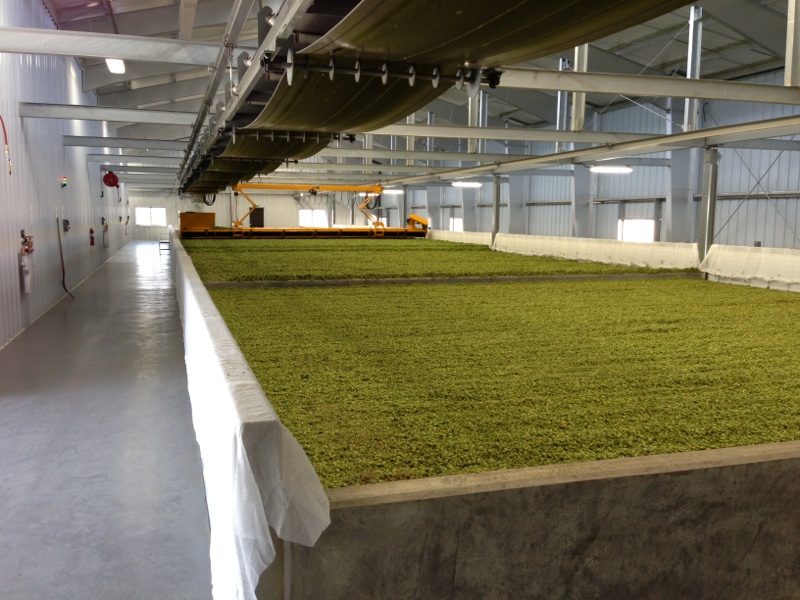Each year, when the calendar strikes August 25, the operations of Perrault Farms kick into high gear.
For the next 35 days, the Toppenish, Wash., facilities operate around the clock to harvest, dry, bale and chill the hops that will be sold to commercial and craft brewers worldwide.
“It’s a very perishable crop,” says Steve Perrault, president of the fourth-generation family business. “Hops are kind of like a wine grape—when they’re ready, they’re ready, and we need to be very efficient at processing them.”
Perrault commissioned new metal buildings to replace the business’ previous cramped and outdated facilities. The buildings are designed to support maximum productivity during the crop’s brief harvesting season.
A 19,530 square-foot hop kiln building is the first stop for the green hop cones after they are stripped from the vines. In this building, propane furnaces blow hot air on the cones to remove excess moisture. The entire process takes about nine hours, 25 percent faster than at the previous facility.
“We’ve cut down our drying time, which has also reduced our propane use and electricity substantially, so it’s a much more sustainable facility,” Perrault says.
After drying, the cones are transported via conveyor to the adjacent 26,000 square-foot hop baling building, where they begin to cool. Ambient air blows through vented air trenches within the concrete floor slab, reducing cone temperature while eliminating the risk of spontaneous combustion.
A four-foot cupola extending the full length of the building allows the moist, hot air to escape out of the roof.
Next, the hop cones are compressed into 200-pound bales, stacked and transported by conveyor to the building’s refrigerated cold room where the temperature is reduced to 28 degrees Fahrenheit.
A second-story office area and conference room at the center of the building overlooks the baling operations, providing a powerful sales tool. The facility also includes a laboratory used in the business’ hop-breeding program as well as an onsite pilot brewery where new varieties of hops can be tested.
The exteriors of both buildings feature metal panels, reinforced concrete tilt-up panels with exposed aggregate finish, and a standing seam metal roof.
“The panels around the buildings contribute to the architectural design and also protect the structures from damage from forklifts and tractors as they maneuver around the site,” says Steve Young, general manager of Concord Construction, the Star builder in Wapato, Wash., that oversaw construction. “The concrete also adds structural strength to the hop baling building when the hops are cooling.”
Extensive use of metal liner wall panels contributes to the structure’s interior aesthetics, and the interior space also features hot dipped galvanized structural steel on all frames, columns and rafters so they won’t be susceptible to rusting from the excess moisture in the air.
The project also includes a 7,500 square-foot equipment cover building.
Because the new facilities process significantly more hops than the previous ones, Perrault Farms has been able to increase the acreage of crops it plants by more than 30 percent.
The new buildings also accommodate the stricter food safety guidelines required by craft brewers, which typically use fresh hops in their brewing process.
“With the craft brewing industry growing so rapidly, food safety is very important to all of us,” Perrault says.
The new complex has definitely impressed other hop farmers in the Yakima Valley, the largest hops-producing region in the U.S.
“Everybody who has gone through the buildings is amazed; it’s one of the top facilities in the industry right now,” Perrault says. “This is something I had to do for the next generations coming up.”
Project construction was completed in 10 months.
“By going with metal buildings from Star Buildings, it really decreases the construction time, which also makes it more cost-effective,” Young says.
Related Stories
| Aug 11, 2010
Burt Hill, HOK top BD+C's ranking of the nation's 100 largest university design firms
A ranking of the Top 100 University Design Firms based on Building Design+Construction's 2009 Giants 300 survey. For more Giants 300 rankings, visit http://www.BDCnetwork.com/Giants
| Aug 11, 2010
PBK, DLR Group among nation's largest K-12 school design firms, according to BD+C's Giants 300 report
A ranking of the Top 75 K-12 School Design Firms based on Building Design+Construction's 2009 Giants 300 survey. For more Giants 300 rankings, visit http://www.BDCnetwork.com/Giants
| Aug 11, 2010
Turner Building Cost Index dips nearly 4% in second quarter 2009
Turner Construction Company announced that the second quarter 2009 Turner Building Cost Index, which measures nonresidential building construction costs in the U.S., has decreased 3.35% from the first quarter 2009 and is 8.92% lower than its peak in the second quarter of 2008. The Turner Building Cost Index number for second quarter 2009 is 837.
| Aug 11, 2010
AGC unveils comprehensive plan to revive the construction industry
The Associated General Contractors of America unveiled a new plan today designed to revive the nation’s construction industry. The plan, “Build Now for the Future: A Blueprint for Economic Growth,” is designed to reverse predictions that construction activity will continue to shrink through 2010, crippling broader economic growth.
| Aug 11, 2010
New AIA report on embassies: integrate security and design excellence
The American Institute of Architects (AIA) released a new report to help the State Department design and build 21st Century embassies.
| Aug 11, 2010
Section Eight Design wins 2009 Open Architecture Challenge for classroom design
Victor, Idaho-based Section Eight Design beat out seven other finalists to win the 2009 Open Architecture Challenge: Classroom, spearheaded by the Open Architecture Network. Section Eight partnered with Teton Valley Community School (TVCS) in Victor to design the classroom of the future. Currently based out of a remodeled house, students at Teton Valley Community School are now one step closer to getting a real classroom.







